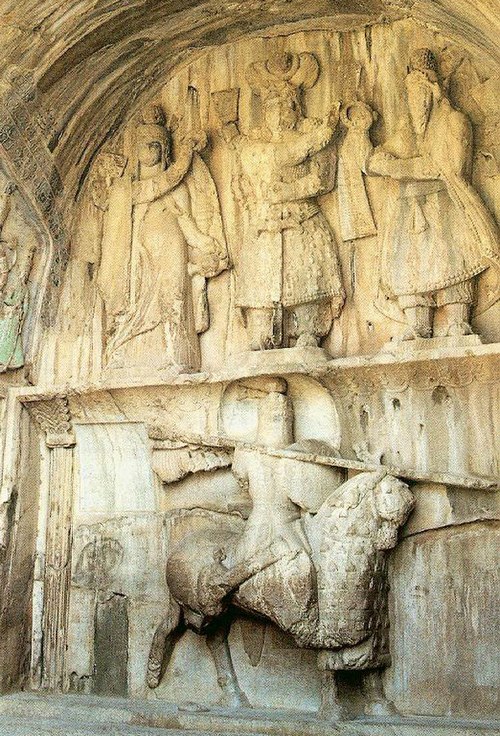| Taq-e Bostan | |
|---|---|
 Taq Bostan, a famous rock relief of Sassanid Iran | |
| Location | Kermanshah, Iran |
| Built | ca. 4th century CE |
| Architectural style | Persian architecture |

Taq-e Bostan (Persian:طاقبستان,Kurdish:تاق وەسان,lit. 'Arch of stone')[1] is a site with a series of largerock reliefs inKermanshah, Iran, carved around the 4th century CE during theSasanian era.
This example ofSasanian art is located 5 km from the city center ofKermanshah. It is located in the heart of theZagros Mountains, where it has endured almost 1,700 years of wind and rain. Originally, severalnatural springs were visible next to and below the reliefs and arches, some of which are now covered. Springs next to the reliefs still feed a large basin in front of the rock. The site has been turned into an archaeological park and a series of late Sasanian and Islamic column capitals have been brought together (some found at Taq Bostan, others atMount Behistun and Kermanshah).
The carvings, some of the finest and best-preserved examples of Persian sculpture under the Sassanids, include representations of the investitures ofArdashir II (379–383) andShapur III (383–388). Like other Sassanid symbols, Taq-e Bostan, and its relief patterns accentuate power, religious tendencies, glory, honour, the vastness of the court, game and fighting spirit, festivity, joy, and rejoicing.
Sassanid kings chose a beautiful setting for their rock reliefs along a historicSilk Road caravan routewaypoint and campground. The reliefs are adjacent to sacred springs that empty into a large reflecting pool at the base of a mountain cliff.
Taq-e Bostan and its rock relief are one of the 30 surviving Sassanid relics of theZagros Mountains. According toArthur Pope, the founder of the Iranian Art and Archeology Institute in the United States of America, "art was characteristic of the Iranian people and the gift which they endowed the world with."
The Taq-e Bostan complex comprise a rock relief standing on its own and several more reliefs associated with two rock cut arches.[citation needed]

The relief panel is approx. 4.07 m wide and 3.9 m high.
The smaller arch oriwan (Taq-e Bustan II) has, on the upper part of the back wall, twoPahlavi inscriptions identifying two royal figures as Shapur II (Shapur the Great) and his son Shapur III. They are shown facing each other. The arch's vestibule measures 6 x 5 x 3.6 meters. It has been suggested as having been built during the reign of Shapur III and some put the date of its completion at 385 AD. However, the royal crown of Shapur III does not agree with those on his coins and is closer to that of his predecessor Ardashir II. It has been argued that the texts represent an usurpation of Ardashir's relief by Shapur III. The translation of the inscriptions follows:
Shapur II inscription :
Shapur III inscription:


The three figures on the back wall of the largeiwan are usually considered to representKhosrow II flanked byAhura Mazda andAnahita.

There are two hunting scenes on each side of the ivan.
The upper relief, added in the 19th century, shows theQajar era Governor inKermanshah,Mohammad-Ali Mirza Dowlatshah, in front ofFath-Ali Shah Qajar.

...in Kermanshahi Kurdish, 'san' means stone and the origin of this name came from stony arches